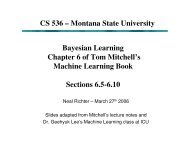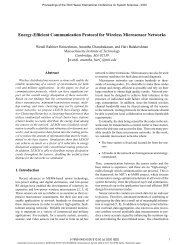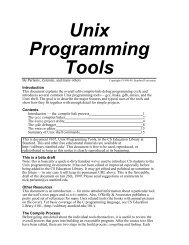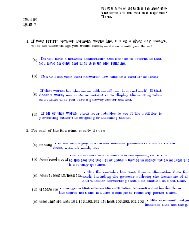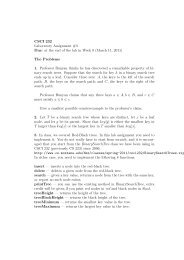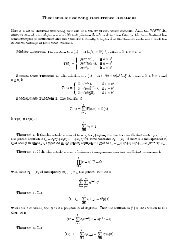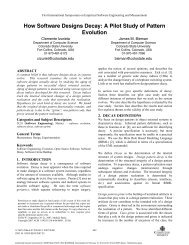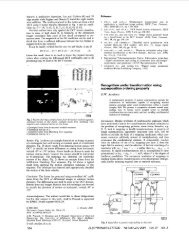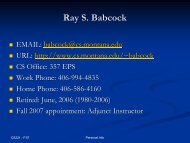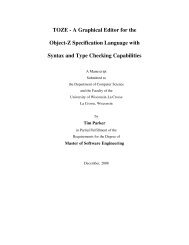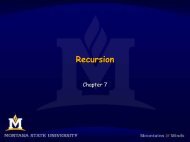Introduction to Software Testing Chapter 2.1, 2.2 Overview Graph ...
Introduction to Software Testing Chapter 2.1, 2.2 Overview Graph ...
Introduction to Software Testing Chapter 2.1, 2.2 Overview Graph ...
You also want an ePaper? Increase the reach of your titles
YUMPU automatically turns print PDFs into web optimized ePapers that Google loves.
<strong>Introduction</strong> <strong>to</strong> <strong>Software</strong> <strong>Testing</strong><br />
<strong>Chapter</strong> <strong>2.1</strong>, <strong>2.2</strong><br />
<strong>Overview</strong> <strong>Graph</strong> Coverage Criteria<br />
Paul Ammann & Jeff Offutt<br />
www.introsoftwaretesting.com
Ch. 2 : <strong>Graph</strong> Coverage<br />
Four Structures for<br />
Modeling <strong>Software</strong><br />
<strong>Graph</strong>s<br />
Logic<br />
Input Space<br />
Syntax<br />
Applied <strong>to</strong><br />
Applied<br />
<strong>to</strong><br />
Source<br />
FSMs<br />
Applied<br />
<strong>to</strong><br />
Specs<br />
DNF<br />
Source<br />
Specs<br />
Source<br />
Models<br />
Design<br />
Use cases<br />
Integ<br />
Input<br />
<strong>Introduction</strong> <strong>to</strong> <strong>Software</strong> <strong>Testing</strong> (Ch 2), www.introsoftwaretesting.com © Ammann & Offutt 2
Covering <strong>Graph</strong>s<br />
(<strong>2.1</strong>)<br />
• <strong>Graph</strong>s are the most commonly used structure for testing<br />
• <strong>Graph</strong>s can come from many sources<br />
– Control flow graphs<br />
– Design structure<br />
– FSMs and statecharts<br />
– Use cases<br />
• Tests usually are intended <strong>to</strong> “cover” the graph in some way<br />
<strong>Introduction</strong> <strong>to</strong> <strong>Software</strong> <strong>Testing</strong> (Ch 2), www.introsoftwaretesting.com © Ammann & Offutt 3
Definition of a <strong>Graph</strong><br />
• A set N of nodes, N is not empty<br />
• A set N 0 of initial nodes, N 0 is not empty<br />
• A set N f of final nodes, N f is not empty<br />
• A set E of edges, each edge from one node <strong>to</strong> another<br />
– ( n i , n j ), i is predecessor, j is successor<br />
<strong>Introduction</strong> <strong>to</strong> <strong>Software</strong> <strong>Testing</strong> (Ch 2), www.introsoftwaretesting.com © Ammann & Offutt 4
Three Example <strong>Graph</strong>s<br />
0<br />
0<br />
1<br />
2<br />
0<br />
1<br />
2<br />
3<br />
4<br />
5<br />
6<br />
1<br />
Not a<br />
valid<br />
graph<br />
2<br />
3<br />
7<br />
8<br />
9<br />
3<br />
N 0 = { 0 }<br />
N 0 = { 0, 1, 2 }<br />
N 0 = { }<br />
N f = { 3 }<br />
N f = { 7, 8, 9 }<br />
N f = { 3 }<br />
<strong>Introduction</strong> <strong>to</strong> <strong>Software</strong> <strong>Testing</strong> (Ch 2), www.introsoftwaretesting.com © Ammann & Offutt 5
Paths in <strong>Graph</strong>s<br />
• Path : A sequence of nodes – [n 1 , n 2 , …, n M ]<br />
– Each pair of nodes is an edge<br />
• Length : The number of edges<br />
– A single node is a path of length 0<br />
• Subpath : A subsequence of nodes in p is a subpath of p<br />
• Reach (n) : Subgraph that can be reached from n<br />
0 1 2<br />
3 4 5 6<br />
7 8<br />
9<br />
Paths<br />
[ 0, 3, 7 ]<br />
[ 1, 4, 8, 5, 1 ]<br />
[ 2, 6, 9 ]<br />
Reach (0) = { 0, 3, 4,<br />
7, 8, 5, 1, 9 }<br />
Reach ({0, 2}) = G<br />
Reach([2,6]) = {2, 6,<br />
9}<br />
<strong>Introduction</strong> <strong>to</strong> <strong>Software</strong> <strong>Testing</strong> (Ch 2), www.introsoftwaretesting.com © Ammann & Offutt 6
Test Paths and SESEs<br />
• Test Path : A path that starts at an initial node and ends at a<br />
final node<br />
• Test paths represent execution of test cases<br />
– Some test paths can be executed by many tests<br />
– Some test paths cannot be executed by any tests<br />
• SESE graphs : All test paths start at a single node and end at<br />
another node<br />
– Single-entry, single-exit<br />
– N0 and Nf have exactly one node<br />
0<br />
1<br />
2<br />
3<br />
4<br />
5<br />
<strong>Introduction</strong> <strong>to</strong> <strong>Software</strong> <strong>Testing</strong> (Ch 2), www.introsoftwaretesting.com © Ammann & Offutt 7<br />
6<br />
Double-diamond graph<br />
Four test paths<br />
[ 0, 1, 3, 4, 6 ]<br />
[ 0, 1, 3, 5, 6 ]<br />
[ 0, 2, 3, 4, 6 ]<br />
[ 0, 2, 3, 5, 6 ]
Visiting and Touring<br />
• Visit : A test path p visits node n if n is in p<br />
A test path p visits edge e if e is in p<br />
• Tour : A test path p <strong>to</strong>urs subpath q if q is a subpath of p<br />
Path [ 0, 1, 3, 4, 6 ]<br />
Visits nodes 0, 1, 3, 4, 6<br />
Visits edges (0, 1), (1, 3), (3, 4), (4, 6)<br />
Tours subpaths (0, 1, 3), (1, 3, 4), (3, 4, 6), (0, 1, 3, 4), (1, 3, 4, 6)<br />
<strong>Introduction</strong> <strong>to</strong> <strong>Software</strong> <strong>Testing</strong> (Ch 2), www.introsoftwaretesting.com © Ammann & Offutt 8
Tests and Test Paths<br />
• path (t) : The test path executed by test t<br />
• path (T) : The set of test paths executed by the set of tests T<br />
• Each test executes one and only one test path<br />
• A location in a graph (node or edge) can be reached from<br />
another location if there is a sequence of edges from the first<br />
location <strong>to</strong> the second<br />
– Syntactic reach : A subpath exists in the graph<br />
– Semantic reach : A test exists that can execute that subpath<br />
<strong>Introduction</strong> <strong>to</strong> <strong>Software</strong> <strong>Testing</strong> (Ch 2), www.introsoftwaretesting.com © Ammann & Offutt 9
Tests and Test Paths<br />
test 1<br />
many-<strong>to</strong>-one<br />
test 2<br />
test 3<br />
Test<br />
Path<br />
Deterministic software – a test always executes the same test path<br />
test 1<br />
test 2<br />
test 3<br />
many-<strong>to</strong>-many<br />
Test Path 1<br />
Test Path 2<br />
Test Path 3<br />
Non-deterministic software – a test can execute different test paths<br />
<strong>Introduction</strong> <strong>to</strong> <strong>Software</strong> <strong>Testing</strong> (Ch 2), www.introsoftwaretesting.com © Ammann & Offutt 10
<strong>Testing</strong> and Covering <strong>Graph</strong>s<br />
(<strong>2.2</strong>)<br />
• We use graphs in testing as follows :<br />
– Developing a model of the software as a graph<br />
– Requiring tests <strong>to</strong> visit or <strong>to</strong>ur specific sets of nodes, edges or subpaths<br />
• Test Requirements (TR) : Describe properties of test paths<br />
• Test Criterion : Rules that define test requirements<br />
• Satisfaction : Given a set TR of test requirements for a criterion C,<br />
a set of tests T satisfies C on a graph if and only if for every test<br />
requirement in TR, there is a test path in path(T) that meets the<br />
test requirement tr<br />
• Structural Coverage Criteria : Defined on a graph just in terms<br />
of nodes and edges<br />
• Data Flow Coverage Criteria : Requires a graph <strong>to</strong> be annotated<br />
with references <strong>to</strong> variables<br />
<strong>Introduction</strong> <strong>to</strong> <strong>Software</strong> <strong>Testing</strong> (Ch 2), www.introsoftwaretesting.com © Ammann & Offutt 11
Node and Edge Coverage<br />
• The first (and simplest) two criteria require that each node and<br />
edge in a graph be executed<br />
Node Coverage (NC) : Test set T satisfies node coverage on<br />
graph G iff for every syntactically reachable node n in N,<br />
there is some path p in path(T) such that p visits n.<br />
• This statement is a bit cumbersome, so we abbreviate it in terms<br />
of the set of test requirements<br />
Node Coverage (NC) : TR contains each reachable node in G.<br />
<strong>Introduction</strong> <strong>to</strong> <strong>Software</strong> <strong>Testing</strong> (Ch 2), www.introsoftwaretesting.com © Ammann & Offutt 12
Node and Edge Coverage<br />
• Edge coverage is slightly stronger than node coverage<br />
Edge Coverage (EC) : TR contains each reachable path of<br />
length up <strong>to</strong> 1, inclusive, in G.<br />
• The “length up <strong>to</strong> 1” allows for graphs with one node and no<br />
edges<br />
• NC and EC are only different when there is an edge and another<br />
subpath between a pair of nodes (as in an “if-else” statement)<br />
0<br />
Node Coverage : TR = { 0, 1, 2 }<br />
Test Path = [ 0, 1, 2 ]<br />
1<br />
2<br />
Edge Coverage : TR = { (0,1), (0, 2), (1, 2) }<br />
Test Paths = [ 0, 1, 2 ]<br />
[ 0, 2 ]<br />
<strong>Introduction</strong> <strong>to</strong> <strong>Software</strong> <strong>Testing</strong> (Ch 2), www.introsoftwaretesting.com © Ammann & Offutt 13
Paths of Length 1 and 0<br />
• A graph with only one node will not have any edges<br />
0<br />
• It may be boring, but formally, Edge Coverage needs <strong>to</strong> require<br />
Node Coverage on this graph<br />
• Otherwise, Edge Coverage will not subsume Node Coverage<br />
– So we define “length up <strong>to</strong> 1” instead of simply “length 1”<br />
• We have the same issue with graphs that only<br />
have one edge – for Edge Pair Coverage …<br />
0<br />
1<br />
<strong>Introduction</strong> <strong>to</strong> <strong>Software</strong> <strong>Testing</strong> (Ch 2), www.introsoftwaretesting.com © Ammann & Offutt 14
Covering Multiple Edges<br />
• Edge-pair coverage requires pairs of edges, or subpaths of<br />
length 2<br />
Edge-Pair<br />
Coverage (EPC) : TR contains each reachable path<br />
of length up <strong>to</strong> 2, inclusive, in G.<br />
• The “length up <strong>to</strong> 2” is used <strong>to</strong> include graphs that have less<br />
than 2 edges<br />
• The logical extension is <strong>to</strong> require all paths …<br />
Complete Path Coverage (CPC) : TR contains all paths in G.<br />
• Unfortunately, this is impossible if the graph has a loop, so a<br />
weak compromise is <strong>to</strong> make the tester decide which paths:<br />
Specified Path Coverage (SPC) : TR contains a set S of test<br />
paths, where S is supplied as a parameter.<br />
<strong>Introduction</strong> <strong>to</strong> <strong>Software</strong> <strong>Testing</strong> (Ch 2), www.introsoftwaretesting.com © Ammann & Offutt 15
1<br />
0<br />
Structural Coverage Example<br />
Node Coverage<br />
TR = { 0, 1, 2, 3, 4, 5, 6 }<br />
Test Paths: [ 0, 1, 2, 3, 6 ] [ 0, 1, 2, 4, 5, 4, 6 ]<br />
Edge Coverage<br />
TR = { (0,1), (0,2), (1,2), (2,3), (2,4), (3,6), (4,5), (4,6), (5,4) }<br />
Test Paths: [ 0, 1, 2, 3, 6 ] [ 0, 2, 4, 5, 4, 6 ]<br />
2<br />
3 4<br />
6<br />
5<br />
Edge-Pair Coverage<br />
TR = { [0,1,2], [0,2,3], [0,2,4], [1,2,3], [1,2,4], [2,3,6],<br />
[2,4,5], [2,4,6], [4,5,4], [5,4,5], [5,4,6] }<br />
Test Paths: [ 0, 1, 2, 3, 6 ] [ 0, 1, 2, 4, 6 ] [ 0, 2, 3, 6 ]<br />
[ 0, 2, 4, 5, 4, 5, 4, 6 ]<br />
Complete Path Coverage<br />
Test Paths: [ 0, 1, 2, 3, 6 ] [ 0, 1, 2, 4, 6 ] [ 0, 1, 2, 4, 5, 4, 6 ]<br />
[ 0, 1, 2, 4, 5, 4, 5, 4, 6 ] [ 0, 1, 2, 4, 5, 4, 5, 4, 5, 4, 6 ] …<br />
<strong>Introduction</strong> <strong>to</strong> <strong>Software</strong> <strong>Testing</strong> (Ch 2), www.introsoftwaretesting.com © Ammann & Offutt 16
Loops in <strong>Graph</strong>s<br />
• If a graph contains a loop, it has an infinite number of paths<br />
• Thus, CPC is not feasible<br />
• SPC is not satisfac<strong>to</strong>ry because the results are subjective and<br />
vary with the tester<br />
• Attempts <strong>to</strong> “deal with” loops:<br />
– 1970s : Execute cycles once ([4, 5, 4] in previous example, informal)<br />
– 1980s : Execute each loop, exactly once (formalized)<br />
– 1990s : Execute loops 0 times, once, more than once (informal description)<br />
– 2000s : Prime paths<br />
<strong>Introduction</strong> <strong>to</strong> <strong>Software</strong> <strong>Testing</strong> (Ch 2), www.introsoftwaretesting.com © Ammann & Offutt 17
Simple Paths and Prime Paths<br />
• Simple Path : A path from node ni <strong>to</strong> nj is simple if no node<br />
appears more than once, except possibly the first and last nodes<br />
are the same<br />
– No internal loops<br />
– Includes all other subpaths<br />
– A loop is a simple path<br />
• Prime Path : A simple path that does not appear as a proper<br />
subpath of any other simple path<br />
0<br />
1 2<br />
3<br />
Simple Paths : [ 0, 1, 3, 0 ], [ 0, 2, 3, 0], [ 1, 3, 0, 1 ],<br />
[ 2, 3, 0, 2 ], [ 3, 0, 1, 3 ], [ 3, 0, 2, 3 ], [ 1, 3, 0, 2 ],<br />
[ 2, 3, 0, 1 ], [ 0, 1, 3 ], [ 0, 2, 3 ], [ 1, 3, 0 ], [ 2, 3, 0 ],<br />
[ 3, 0, 1 ], [3, 0, 2 ], [ 0, 1], [ 0, 2 ], [ 1, 3 ], [ 2, 3 ], [ 3, 0 ],<br />
[0], [1], [2], [3]<br />
Prime Paths : [ 0, 1, 3, 0 ], [ 0, 2, 3, 0], [ 1, 3, 0, 1 ],<br />
[ 2, 3, 0, 2 ], [ 3, 0, 1, 3 ], [ 3, 0, 2, 3 ], [ 1, 3, 0, 2 ],<br />
[ 2, 3, 0, 1 ]<br />
<strong>Introduction</strong> <strong>to</strong> <strong>Software</strong> <strong>Testing</strong> (Ch 2), www.introsoftwaretesting.com © Ammann & Offutt 18
Prime Path Coverage<br />
• A simple, elegant and finite criterion that requires loops <strong>to</strong> be<br />
executed as well as skipped<br />
Prime Path Coverage (PPC) : TR contains each prime path in G.<br />
• Will <strong>to</strong>ur all paths of length 0, 1, …<br />
• That is, it subsumes node, edge, and edge-pair coverage<br />
<strong>Introduction</strong> <strong>to</strong> <strong>Software</strong> <strong>Testing</strong> (Ch 2), www.introsoftwaretesting.com © Ammann & Offutt 19
Round Trips<br />
• Round-Trip Path : A prime path that starts and ends at the same<br />
node<br />
Simple Round Trip Coverage (SRTC) : TR contains at least<br />
one round-trip<br />
path for each reachable node in G that begins<br />
and ends a round-trip<br />
path.<br />
Complete Round Trip Coverage (CRTC) : TR contains all<br />
round-trip<br />
paths for each reachable node in G.<br />
• These criteria omit nodes and edges that are not in round trips<br />
• That is, they do not subsume edge-pair, edge, or node coverage<br />
<strong>Introduction</strong> <strong>to</strong> <strong>Software</strong> <strong>Testing</strong> (Ch 2), www.introsoftwaretesting.com © Ammann & Offutt 20
Prime Path Example<br />
• The previous example has 38 simple paths<br />
• Only nine prime paths<br />
0<br />
1<br />
2<br />
3 4<br />
6<br />
5<br />
Prime Paths<br />
[ 0, 1, 2, 3, 6 ]<br />
[ 0, 1, 2, 4, 5 ]<br />
[ 0, 1, 2, 4, 6 ]<br />
[ 0, 2, 3, 6 ]<br />
[ 0, 2, 4, 5]<br />
[ 0, 2, 4, 6 ]<br />
[ 5, 4, 6 ]<br />
[ 4, 5, 4 ]<br />
[ 5, 4, 5 ]<br />
Execute<br />
loop 0 times<br />
Execute<br />
loop once<br />
Execute loop<br />
more than once<br />
<strong>Introduction</strong> <strong>to</strong> <strong>Software</strong> <strong>Testing</strong> (Ch 2), www.introsoftwaretesting.com © Ammann & Offutt 21
Touring, Sidetrips and De<strong>to</strong>urs<br />
• Prime paths do not have internal loops … test paths might<br />
• Tour : A test path p <strong>to</strong>urs subpath q if q is a subpath of p<br />
• Tour With Sidetrips : A test path p <strong>to</strong>urs subpath q with sidetrips<br />
iff every edge in q is also in p in the same order<br />
• The <strong>to</strong>ur can include a sidetrip, as long as it comes back <strong>to</strong> the same node<br />
• Tour With De<strong>to</strong>urs : A test path p <strong>to</strong>urs subpath q with de<strong>to</strong>urs iff<br />
every node in q is also in p in the same order<br />
• The <strong>to</strong>ur can include a de<strong>to</strong>ur from node ni, as long as it comes back <strong>to</strong><br />
the prime path at a successor of ni<br />
<strong>Introduction</strong> <strong>to</strong> <strong>Software</strong> <strong>Testing</strong> (Ch 2), www.introsoftwaretesting.com © Ammann & Offutt 22
Sidetrips and De<strong>to</strong>urs Example<br />
1 2 3 4<br />
0 1 2 4 5<br />
Touring without<br />
sidetrips or<br />
3<br />
de<strong>to</strong>urs<br />
1 2 5 6<br />
0 1 2 4 5<br />
Touring with a<br />
sidetrip<br />
3 4<br />
3<br />
1 2 5<br />
0 1 2 4 5<br />
Touring with a<br />
de<strong>to</strong>ur<br />
3<br />
3<br />
4<br />
<strong>Introduction</strong> <strong>to</strong> <strong>Software</strong> <strong>Testing</strong> (Ch 2), www.introsoftwaretesting.com © Ammann & Offutt 23
Infeasible Test Requirements<br />
• An infeasible test requirement cannot be satisfied<br />
– Unreachable statement (dead code)<br />
– A subpath that can only be executed if a contradiction occurs (X > 0 and X < 0)<br />
• Most test criteria have some infeasible test requirements<br />
• It is usually undecidable whether all test requirements are<br />
feasible<br />
• When sidetrips are not allowed, many structural criteria have<br />
more infeasible test requirements<br />
• However, always allowing sidetrips weakens the test criteria<br />
Practical recommendation – Best Effort Touring<br />
– Satisfy as many test requirements as possible without sidetrips<br />
– Allow sidetrips <strong>to</strong> try <strong>to</strong> satisfy unsatisfied test requirements<br />
<strong>Introduction</strong> <strong>to</strong> <strong>Software</strong> <strong>Testing</strong> (Ch 2), www.introsoftwaretesting.com © Ammann & Offutt 24
Simple & Prime Path Example<br />
1<br />
0<br />
2<br />
3 4<br />
6<br />
Simple<br />
paths<br />
5<br />
Len 0<br />
[0]<br />
[1]<br />
[2]<br />
[3]<br />
[4]<br />
[5]<br />
[6] !<br />
Len 1<br />
[0, 1]<br />
[0, 2]<br />
[1, 2]<br />
[2, 3]<br />
[2, 4]<br />
[3, 6] !<br />
[6] ! [4, 6] !<br />
[4, 5]<br />
[5, 4]<br />
Len 4<br />
[0, 1, 2, 3, 6] !<br />
[0, 1, 2, 4, 6] !<br />
[0, 1, 2, 4, 5] !<br />
‘!’ means path<br />
Len terminates 2 Len 3<br />
[0, 1, 2] [0, 1, ‘*’ 2, means 3] path<br />
[0, 2, 3] [0, 1, 2, 4] cycles<br />
[0, 2, 4] [0, 2, 3, 6] !<br />
[1, 2, 3] [0, 2, 4, 6] !<br />
[1, 2, 4] [0, 2, 4, 5] !<br />
[2, 3, 6] ! [1, 2, 3, 6] !<br />
[2, 4, 6] !<br />
[2, 4, 5] !<br />
[4, 5, 4] *<br />
[5, 4, 6] !<br />
[5, 4, 5] *<br />
[1, 2, 4, 5] !<br />
[1, 2, 4, 6] !<br />
Prime Paths<br />
<strong>Introduction</strong> <strong>to</strong> <strong>Software</strong> <strong>Testing</strong> (Ch 2), www.introsoftwaretesting.com © Ammann & Offutt 25
Data Flow Criteria<br />
Goal: Try <strong>to</strong> ensure that values are computed and used correctly<br />
• Definition (def) : A location where a value for a variable is<br />
s<strong>to</strong>red in<strong>to</strong> memory<br />
• Use : A location where a variable’s value is accessed<br />
• def (n) or def (e) : The set of variables that are defined by node n<br />
or edge e<br />
• use (n) or use (e) : The set of variables that are used by node n<br />
or edge e<br />
X = 42<br />
0<br />
1<br />
2<br />
3<br />
Z = X*2<br />
4<br />
5<br />
Z = X-8<br />
6<br />
Defs: def (0) = {X}<br />
def (4) = {Z}<br />
def (5) = {Z}<br />
Uses: use (4) = {X}<br />
use (5) = {X}<br />
<strong>Introduction</strong> <strong>to</strong> <strong>Software</strong> <strong>Testing</strong> (Ch 2), www.introsoftwaretesting.com © Ammann & Offutt 26
DU Pairs and DU Paths<br />
• DU pair : A pair of locations (l i , l j ) such that a variable v is<br />
defined at l i and used at l j<br />
• Def-clear : A path from l i <strong>to</strong> l j is def-clear with respect <strong>to</strong><br />
variable v if v is not given another value on any of the nodes or<br />
edges in the path<br />
• Reach : If there is a def-clear path from l i <strong>to</strong> l j with respect <strong>to</strong> v,<br />
the def of v at l i reaches the use at l j<br />
• du-path : A simple subpath that is def-clear with respect <strong>to</strong> v<br />
from a def of v <strong>to</strong> a use of v<br />
• du (n i , n j , v) – the set of du-paths from n i <strong>to</strong> n j<br />
• du (n i , v) – the set of du-paths that start at n i<br />
<strong>Introduction</strong> <strong>to</strong> <strong>Software</strong> <strong>Testing</strong> (Ch 2), www.introsoftwaretesting.com © Ammann & Offutt 27
Touring DU-Paths<br />
• A test path p du-<strong>to</strong>urs subpath d with respect <strong>to</strong> v if p <strong>to</strong>urs d and<br />
the subpath taken is def-clear with respect <strong>to</strong> v<br />
• Sidetrips can be used, just as with previous <strong>to</strong>uring<br />
• Three criteria<br />
– Use every def<br />
– Get <strong>to</strong> every use<br />
– Follow all du-paths<br />
<strong>Introduction</strong> <strong>to</strong> <strong>Software</strong> <strong>Testing</strong> (Ch 2), www.introsoftwaretesting.com © Ammann & Offutt 28
Data Flow Test Criteria<br />
• First, we make sure every def reaches a use<br />
All-defs<br />
coverage (ADC) : For each set of du-paths<br />
S = du (n,<br />
v),<br />
TR contains at least one path d in S.<br />
• Then we make sure that every def reaches all possible uses<br />
All-uses<br />
coverage (AUC) : For each set of du-paths<br />
<strong>to</strong> uses S =<br />
du (n i , n j , v),<br />
TR contains at least one path d in S.<br />
• Finally, we cover all the paths between defs and uses<br />
All-du-paths<br />
coverage (ADUPC) : For each set S = du (ni,<br />
nj,<br />
v),<br />
TR contains every path d in S.<br />
<strong>Introduction</strong> <strong>to</strong> <strong>Software</strong> <strong>Testing</strong> (Ch 2), www.introsoftwaretesting.com © Ammann & Offutt 29
Data Flow <strong>Testing</strong> Example<br />
Z = X*2<br />
X = 42<br />
0<br />
1<br />
3<br />
4<br />
6<br />
2<br />
5<br />
Z = X-8<br />
All-defs for X<br />
[ 0, 1, 3, 4 ]<br />
All-uses for X<br />
[ 0, 1, 3, 4 ]<br />
[ 0, 1, 3, 5 ]<br />
All-du-paths for X<br />
[ 0, 1, 3, 4 ]<br />
[ 0, 2, 3, 4 ]<br />
[ 0, 1, 3, 5 ]<br />
[ 0, 2, 3, 5 ]<br />
<strong>Introduction</strong> <strong>to</strong> <strong>Software</strong> <strong>Testing</strong> (Ch 2), www.introsoftwaretesting.com © Ammann & Offutt 30
<strong>Graph</strong> Coverage Criteria Subsumption<br />
Complete Path<br />
Coverage<br />
CPC<br />
All-DU-Paths<br />
Coverage<br />
ADUP<br />
All-uses<br />
Coverage<br />
AUC<br />
All-defs<br />
Coverage<br />
ADC<br />
Edge-Pair<br />
Coverage<br />
EPC<br />
Edge<br />
Coverage<br />
EC<br />
Node<br />
Coverage<br />
NC<br />
Prime Path<br />
Coverage<br />
PPC<br />
Complete Round<br />
Trip Coverage<br />
CRTC<br />
Simple Round<br />
Trip Coverage<br />
SRTC<br />
<strong>Introduction</strong> <strong>to</strong> <strong>Software</strong> <strong>Testing</strong> (Ch 2), www.introsoftwaretesting.com © Ammann & Offutt 31



